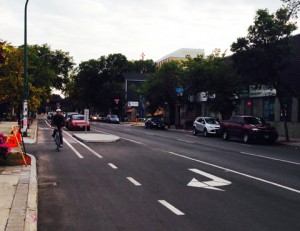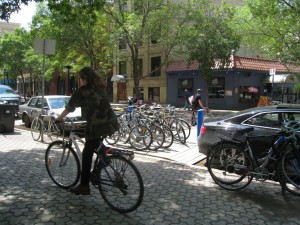One year after the final set of public open houses for the Winnipeg Pedestrian and Cycling Strategies, formal approval by City Council is still pending. This 334-page document will guide improvements over the next couple of decades to make walking and cycling more attractive and comfortable for residents and visitors to Winnipeg.
Green Action Centre, along with other organizations such as Bike Winnipeg and the Winnipeg Trails Association, appeared before both the Standing Policy Committee on Public Works and Infrastructure Renewal and Executive Policy Committee in early May to speak in favour of adopting the Strategies.
While the City’s decision was delayed until June, here are Green Action Centre’s Top 10 reasons to approve the Winnipeg Pedestrian and Cycling Strategies:
- The Strategies’ recommendations are based on equity and opportunity for walking and cycling across the city. Fair plus best bang for buck.
 There was more public consultation and public engagement for these Strategies than most major road work projects. Enough talk – we’re ready for action.
There was more public consultation and public engagement for these Strategies than most major road work projects. Enough talk – we’re ready for action.- They provide critical guidance on where Winnipeg is at now, where we want to go and ways to get there. A blueprint with flexibility.
- They reflect what Winnipeggers want – walking and cycling infrastructure that makes them feel safe and comfortable. Whether 8 or 80 yrs old: All ages and abilities.
 Winnipeggers are ready to embrace walking and cycling (integrated with transit). While organizers expected perhaps 15% of fans would bus, bike or walk to the new stadium – in fact, 39% did so for the first regular home game. Winnipeggers want to walk and bike.
Winnipeggers are ready to embrace walking and cycling (integrated with transit). While organizers expected perhaps 15% of fans would bus, bike or walk to the new stadium – in fact, 39% did so for the first regular home game. Winnipeggers want to walk and bike.- Every resident across Winnipeg will benefit from this $330 million compared with a single road or bridge project that benefits motorists in one area of the city. Benefit-cost ratio = solid investment.
 Businesses can benefit – the experience in other cities is that business increases or stays neutral when a bike lane goes in. Bikes are good for business.
Businesses can benefit – the experience in other cities is that business increases or stays neutral when a bike lane goes in. Bikes are good for business.- Tourism benefits – visitors today want to be able to get around easily downtown and to major destinations on foot or by bike. Tourists on foot / bike bring dollars.
- Millennials (those born after 1980) are driving less and want to live in walkable / bikeable cities. Attract and keep young people in Winnipeg.
 The Strategies support Active and Safe Routes to School, which will help more children walk and bike safely in their neighbourhood. Children deserve safe routes to school.
The Strategies support Active and Safe Routes to School, which will help more children walk and bike safely in their neighbourhood. Children deserve safe routes to school.
In a nutshell, the Pedestrian and Cycling Strategies provide a framework for planning, designing and implementing walking and cycling infrastructure. They present a tremendous opportunity for Winnipeg to shift from an auto-centric approach in transportation planning to one that is inclusive of all modes, ages and abilities.
In fact, we at Green Action Centre would like to see much stronger language in the Strategies to go beyond the stated goal of maximizing transportation options to one that specifically prioritizes walking, cycling and transit use over driving alone in a car. It is time that Winnipeg takes the next step to recognize there is a hierarchy of users in planning transportation systems – it is time to place priority on pedestrians and cyclists followed by transit users then commercial vehicles/trucks, multi-occupant vehicles and finally, single occupant vehicles. We need to invert the transportation hierarchy in Winnipeg, which for decades has placed the single occupant vehicle as the top priority.



Recent Comments